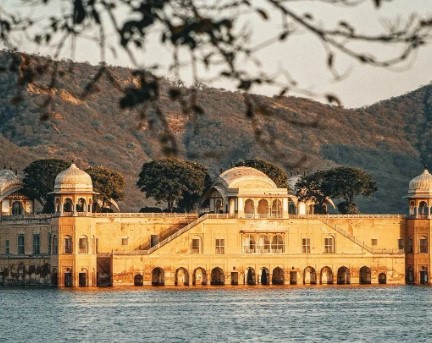Palaces and forts of Rajasthan
Palaces and forts of Rajasthan
Palaces
Palaces are
the most important foci of tourist’s interest in Rajasthan. Most of the palaces
form a group of magnificent edifices of granite, marble and sand stone and are
erected on a solid high natural plinth. These dignified buildings present a
real view of the finest specimen of Rajput art and architecture. They contain a
hall of mirrors, a big meeting hall, coronation room, entertainment
compartment, Ranwas (compartments for Ranis) sleeping room, guest room and a
religious spot for their own divine deity nearby.
Sculpture,
painting and architecture attended their high mark in these princely mansions.
Amongst, Maharana's palaces of Udaipur, situated on the western extremity of
the city with the lake Pichhola at their background, present a thrilling view
before a tourist. Along the shores of Pichhola, the snow-white balcony,
promontories, esplanades, quay, pillars, windows, ornamental arches, huge high
straight walls and decorated domes offer a lovely sight to the visitors. They
are described by Fergusson as 'resembling Windsor in their thickness and boundaries’.
The
principle centres of attraction are beautiful peacocks in various styles in
mosaic on the walls, floors inlaid with tiles of charming and rare design and roof
garden with huge trees, therefore, and affording enchanting views of the
panorama below. Two islands of Udaipur in lake Pichhola have crowned the
beautiful gem like palaces viz. Jagmandir and Jagniwas. Jagmandir is famous in
history as an asylum to Prince Khurram, later on emperor Shahjahan, after he
revolted against his father Jahangir. It is believed that this palace inspired
Prince Khurram to construct the Maharana's. Again Fergusson observed that they are
luxury hotel, happened to be the summer palace of the Taj on a grand scale.
Jagniwas, now a purely modernise unmatched in the world. In his words, 'I know
of nothing that will bear comparison with them anywhere’?
The palaces
of Amber, the City Palace, the Residency palace, Hawa Mahal, the Chandra Mahal
of the Maharaja’s of Jaipur are the best specimen of Rajput architecture.
Inside these palaces are the best quaint paintings, floral decorations, museum
of weapons, and mirrors. According to Aldous Huxely, They surpass even the
famous mirror room at Bagheria near Palermo.
Amber
Palace is a superb
example of Rajput architecture. Its terraces and ramparts are reflected in the Maota
lake below. Within the Palace are the Diwan-I-Am. Jaisingh's Palace with carved
pillars, the extensive wall paintings, the Sukh Niwas, Jai Mandir and Kali
temple.
 |
| Amber fort, Jaipur |
Hawa
Mahal was
elaborately designed by Lal Chand Ustad for use by the royal family during
summer. Because of its airiness, it is known as Hawa Mahal i.e. the palace of
air or winds. Air in Rajasthan called Hawa. The lovely and durling pyramidal
loam of this seven storeyed building in pink masonry, peculiar and exquisite
arches with double uncovered foils domed pavilions, attracts large number of
tourists and is really a source of enjoyment, especially to visitors and
tourists. The Hawa Mahal was immortalized by Sir Edwin Arnold as a vision of darling
and dainty loveliness a very mountain of airy and audacious beauty. Jaipur City
Palace contains the seven storeyed edifice of Chandra Mahal. Inside the palace there
are quaint paintings, floral decorations and beautifully fixed mirrors.
The
Chhitar Palace of Jodhpur is also an exotic piece of fine art within which armoury, collection of old
manuscripts and paintings, tiger heads, beautiful tank, and the like are the
main centres of attraction. Because of the Chhitar sandstone used in building,
it is popularly known as Chhitar palace whereas it was built by Maharaja Ummed
Singh in 1930-40 and is named after him.
Lalgarh
Palace or Red fort
was built by Maharaja Ganga Singh in the memory of his father Maharaja LalSingh.
It is an imposing edifies of carved red sand stone and is characterised by its marvellous
lattice work.
Ganga
Niwas (Bikaner): The
specious Darbar Hall is a recent building. It is probably the only building in
Rajasthan with a ceiling of carved wood, while the interiors faced with richly
carved red sand stone.
Gopal
Bhawan (Deeg): The
garden palace was created by Raja Soorajmal which Fergusson puts it wants the
massive character of the fortified palaces of other Rajput States, but for
grandeur of conception and beauty of detail, surpasses them all'. It is the
most outstanding example of the Mughal architecture in its last phase.
Phool
Mahal (Bundi) or the Flower Palace has banquet rooms and halls decorated with a large collection
of hunting trophies. Besides these, Nikumbha Mahal, Suraj Mahal, City Palace of
Alwar; Moti Mahal of Bharatpur; WoodenPalace of the Maharaja of Jhalawar,
Palaces of Bundi etc,are beautiful in their own way, appearance and grandeur.
Forts.
The chief
lure of the tourists lies in the forts of Rajasthan which crowned every hill
top and possess straight positions in the different parts of the state. The
rulers and the chiefs of the different erstwhile states of Rajputana
constructed such huge and gigantic forts encircled by wall with strong gates to
safeguard their own estate from the periodical devastations and battles
inflicted by the plunders and outside enemies. Most of these forts contain a
palace, meeting place, religious spot of the divine deity, arsenal, and
treasury for the use of feudal family. Among the famous forts of Rajasthan are Chittorgarh,
Ranthambhor, Bhainsrodgarh, Kumbhal-garh, Gagron, Mandalgarh, Nahargarh,
Taragarh, Jaigarh,Amber, Jodhpur, Lalgarh (Bikaner), Deeg, Alwar,Jaisalmer,
Bharatpur, Hanumangarh, Bundi, Sajjangarh and Rajgarh fort. Among these,
Chittorgarh, Bharatpur,Kumbhalgarh, Jodhpur and some other forts are worth-mentioning.
The
historical fort of Chittor, celebrated in the annals of Mewar and situated 111 kms, to the east of
Udaipur, is richly reminiscent of the age of Rajput velour and chivalry. Among
the many objects and architectural pieces of wonder are Jai Stambha (the tower
of victory),Kirti Stambha, Palaces of Rana Kumbha, Palace of Padmini, Palaces
of Jaimal & Patta (celebrated warriors)etc.
Bharatpur
fort or Lohagarh fort or Iron fort is invincible because of its sandy ramparts strengthened by
sandy battlements before which most modern guns proved futile. The British
armies had to withdraw for four times due to the unconquerableness of the fort.
Kumbhalgarh
fort stands on a
craggy mountains and commands a fine view of the Aravallis and the sandydesert
in Mewar. It was only this fort on that the rulers of Mewar always turned their
eyes when Udaipur become unsafe and chittor untenable.
Jodhpur Fort(Mehrahgarh) is most
striking magnificent and enchanting in India. It gives a superb view of the
whole Marushthali. The fort was named as Maherangarh whichmeans the majestic
fort. This fort crowns or isolated perpendicular cliff paternally guarding the
city below with the grandeur of the yester years.
Junagarh
Fort (Bikaner) was
built by Raja Rai Singh which is encircled by a moat and contains various palaces,
made of red sandstone and marble wit kiosks and balconies.
Jaiselmer fort - Jaisalmer Fort, also known as the Golden Fort, is a magnificent fortress located in the city of Jaisalmer in Rajasthan, India. Built in 1156 AD by Rawal Jaisal, a Rajput ruler, it stands proudly on Trikuta Hill, overlooking the golden sands of the Thar Desert.
Taragarh Fort(Ajmer) was built by Raja Ajaipal who founded Ajmer, on a hill. It is a rectangular fortress. Itis also known as Garh Beetlli because it stands on Beetlihill.
Ranthambhor fort, situated on isolated rock, is symbolic of solidity and strength it displayed on many occasions. There are remains of a palace, a few temples and cenotaphs, besides a number of tanks and reservoirs within its ramparts. The thick jungles around abound in game of all kinds. With these and a host of other attractions, forts of Rajasthan attract many visitors.
Thankyou
comment your queries below









0 Comments